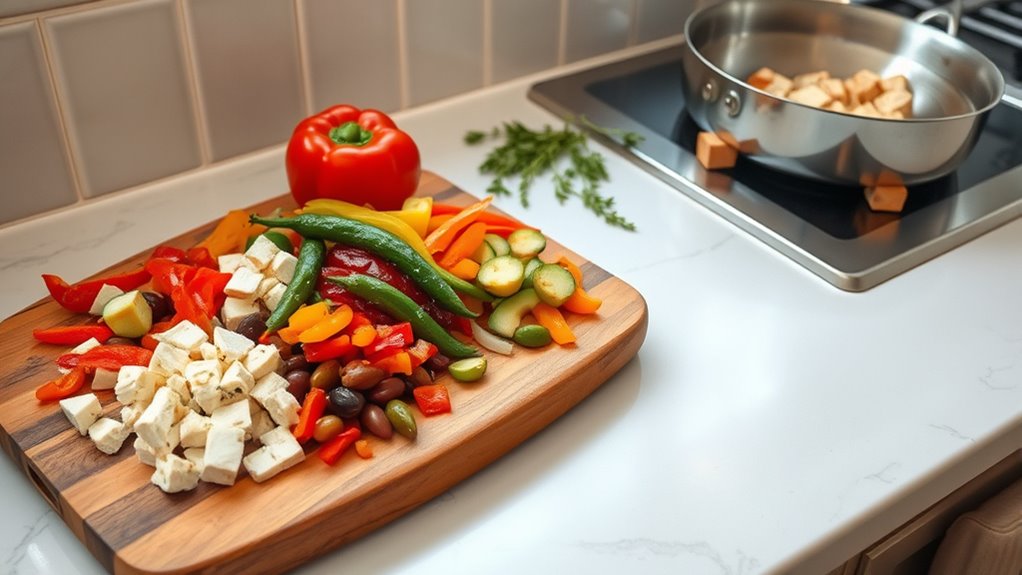To master plant-based proteins like tofu and beans, start by understanding their textures and best uses—silken for smoothies, firm for stir-fries, chickpeas for hummus, and kidney beans for hearty stews. Experiment with marinating, soaking, or pressing to enhance flavor and texture. Incorporating a variety of beans and tofu types helps create satisfying, flavorful dishes. Keep exploring these options; you’ll discover new ways to enjoy nutritious plant-based meals every time you try something new.
Key Takeaways
- Different tofu textures (silken, soft, firm, extra-firm) suit various dishes, from smoothies to stir-fries.
- Rinse and soak beans like chickpeas and kidney beans to improve flavor and reduce cooking time.
- Press tofu to remove excess moisture, enhancing flavor absorption and texture during cooking.
- Combining diverse plant proteins offers nutritional balance and culinary variety in your meals.
- Experiment with seasonings, marinating, and cooking methods to make plant-based dishes more flavorful and satisfying.

Have you ever wondered how plant-based proteins can meet your nutritional needs? The good news is, with a little knowledge and experimentation, you can turn tofu, beans, and other plant ingredients into delicious, protein-packed meals. Tofu, for example, comes in a variety of textures that make it incredibly versatile. Silken tofu melts smoothly into smoothies and sauces, while soft tofu works well in soups and stews. Firm and extra-firm tofu hold their shape better, making them perfect for stir-fries, grilling, or baking. Knowing the different tofu textures helps you choose the right type for your dish, ensuring it turns out satisfying and flavorful. It’s worth trying each texture to see what works best for your cooking style and taste preferences. High refresh rates in kitchen appliances can also enhance your cooking experience by making processes like blending and mixing more efficient.
Exploring tofu textures enhances your plant-based cooking and ensures flavorful, satisfying meals.
When it comes to beans, there’s a wide range of varieties, each offering unique flavors and textures. Black beans are hearty and slightly sweet, great for tacos, salads, or chili. Chickpeas have a nutty taste and firm texture that makes them perfect for roasting, adding to curries, or turning into hummus. Kidney beans are dense and meaty, ideal in stews or mixed into rice dishes. Lentils, with their quick cooking time, come in different colors—green, brown, red—and are excellent in soups, salads, or as a base for veggie patties. Each bean variety provides a different nutritional profile, so combining them helps you get a broader spectrum of essential amino acids and other nutrients. Plus, experimenting with different beans can inspire new recipes and keep your meals interesting.
Cooking with plant-based proteins isn’t just about replacing meat; it’s about exploring textures and flavors that can elevate your dishes. When preparing tofu, pressing out excess moisture improves its ability to absorb flavors and achieve a better texture, whether crispy or tender. Marinating tofu before cooking enhances its taste and adds layers of flavor. For beans, soaking and rinsing help reduce cooking time and remove any bitterness. Using a variety of bean types in your recipes adds depth and complexity, making your meals more satisfying. You can even combine tofu and beans in a single dish for added protein and texture contrast. The key is to be open to trying different preparations and seasoning methods—this keeps your plant-based cooking exciting and nutritious.
In the end, understanding tofu textures and bean varieties empowers you to create meals that are not only healthful but also delicious. With a little practice, you’ll discover how versatile and filling plant-based proteins can be, helping you meet your nutritional needs while enjoying a diverse range of flavors and textures.
Frequently Asked Questions
How Do I Store Cooked Plant-Based Proteins Properly?
You should store cooked plant-based proteins in airtight containers in the refrigerator, following refrigeration guidelines to keep them fresh for up to 3-4 days. For longer storage, use freezing techniques—place them in freezer-safe bags or containers, removing excess air. Label and date them to prevent freezer burn and guarantee quality. When you’re ready to eat, thaw in the fridge or microwave, then reheat thoroughly.
Can Plant Proteins Replace All Animal Proteins in My Diet?
You can replace all animal proteins with plant proteins, but it requires planning for nutritional completeness. Think of your diet like a balanced puzzle—include a variety of beans, tofu, nuts, and grains. This approach helps meet essential amino acids and nutrients. Plus, switching to plant-based proteins reduces your environmental impact considerably. Just make certain you’re consuming diverse sources to maintain ideal health while making eco-friendly choices.
Are There Any Allergens in Common Plant-Based Proteins?
Yes, some plant-based proteins can cause allergenic concerns. Common allergens include soy, nuts, and gluten, which may trigger reactions in sensitive individuals. Cross reactivity issues are also possible; for example, those allergic to peanuts might react to soy. it is crucial to check labels and consult with a healthcare professional if you have known food allergies or sensitivities, ensuring you select proteins that are safe for you.
How Do I Improve the Flavor of Bland Tofu or Beans?
Ever wonder how to turn bland tofu or beans into flavorful dishes? You can enhance their taste with marinade techniques, soaking them in tasty blends of soy sauce, garlic, and spices. Also, try seasoning blends like curry powder or smoked paprika to add depth. Let them sit for at least 30 minutes, then cook to absorb all those flavors. Isn’t it satisfying to transform simple ingredients into delicious meals?
What Are the Best Plant Proteins for Athletes?
You should focus on plant protein varieties like lentils, chickpeas, quinoa, and edamame, as they provide essential amino acids vital for athlete nutrition. Incorporate a mix of these sources into your meals to guarantee balanced intake and ideal recovery. These proteins are versatile, easy to prepare, and support muscle repair and energy needs, making them excellent choices for athletes seeking plant-based options to enhance performance and overall health.
Conclusion
Now that you know how to cook tofu, beans, and more, you’re ready to embrace plant-based proteins with confidence. You can experiment, adapt, and enjoy every delicious bite. You can choose textures, try flavors, and create meals that nourish your body and delight your taste buds. With these simple steps, you can cook, customize, and enjoy plant-based proteins anytime, anywhere. So, go ahead—cook, explore, and savor the vibrant world of plant-based eating!









